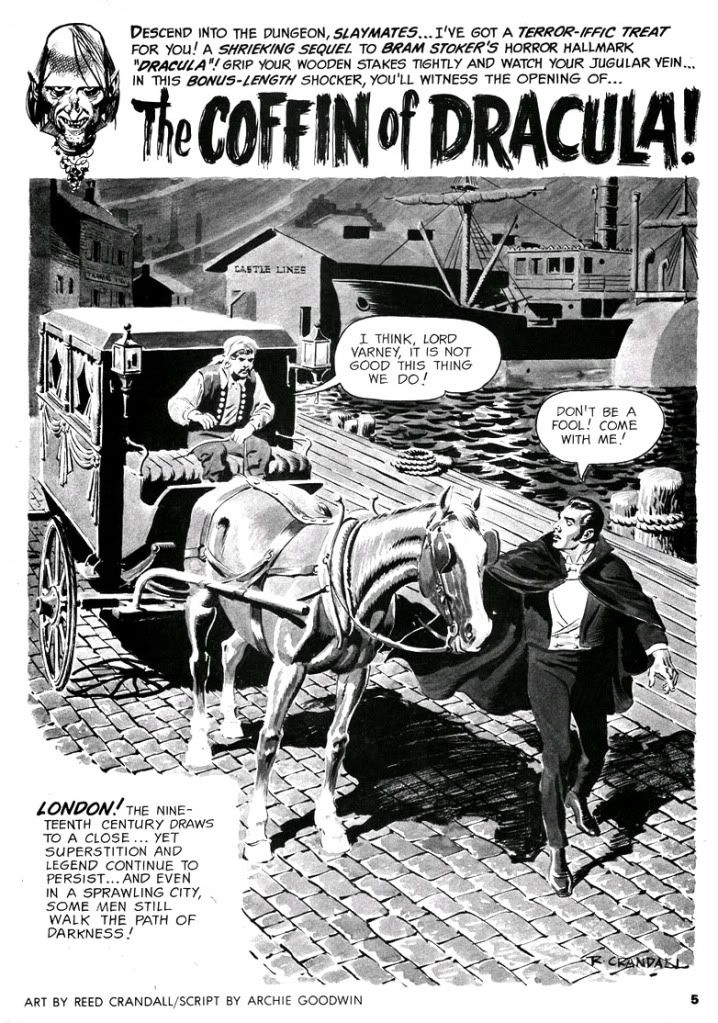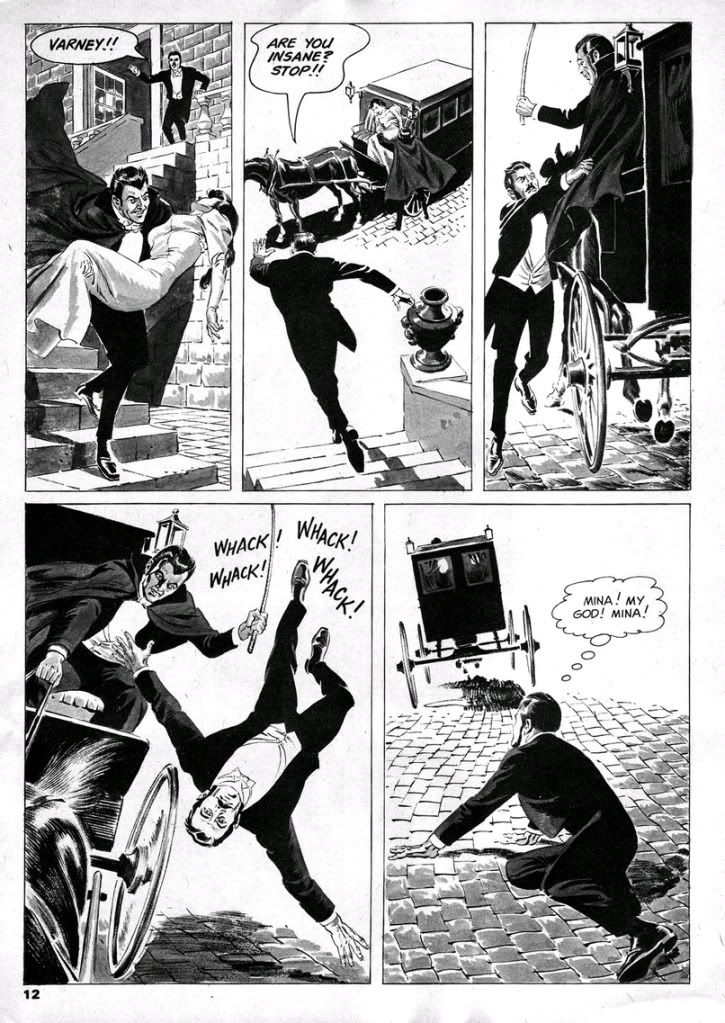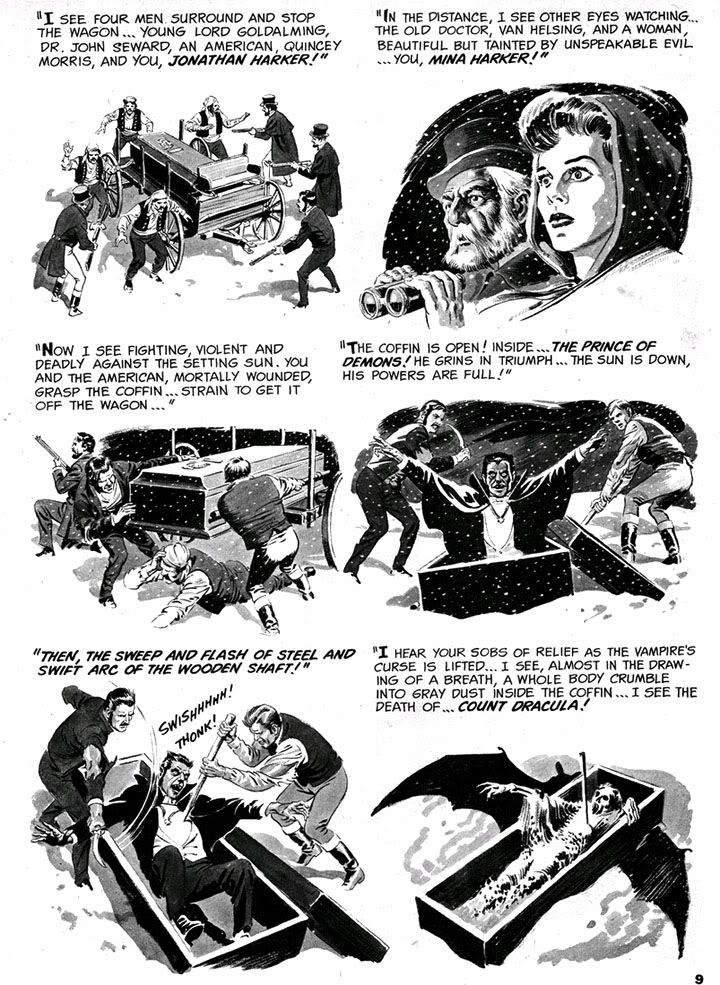Dracula didn't really cry out for a sequel, but for over a century now Bram Stoker's vampire character has proven so appealing writers have been unable to leave the poor, exhausted bastard undead, the end result being he's so ingrained in our pop culture his image has even been used to sell chocolatey breakfast cereal. You can imagine, if you will, his staked, beheaded bones lying in his coffin still somewhere in the mountains of Transylvania, just as he was at the end of the original novel. Or you allow any of the later incarnations where the vampire comes back to unlife into your personal Dracula canon. Or you can be like me and just separate them all and not really care if one is a continuation or a side story or parody or whatever.
For Warren's Creepy magazine, Archie Goodwin and Reed Crandall created a two-part sequel centering on one Lord Varney (his name borrowed from one of Dracula's vampire antecedents) and his stupid misadventures with Dracula's coffin. Not that the story is stupid. It's not exactly a classic-- although Warren thought highly enough of it to reprint it in one of their best-of issues-- but Varney's the idiot here. What kind of fool buys Dracula's coffin and climbs into it? It's a bonehead move by an arrogant jackass and actually one of the most bizarre ways I've yet seen of contracting the dread disease we know as gingivitis. I mean, vampirism.
Seriously, if you must become a vampire, have the common decency to drink the blood of one of the undead. Get your own coffin. Sharing coffins isn't sanitary, anyway. And it's not true vampirism. It's more like possession at first. Varney can't even get that right. Man, I hate this Varney guy!
Part one clawed its way out of the crypt in time to anchor Creepy #8 (April 196), while part two coalesced from swirling ash in #9 (June 1966). Both segments are gorgeously illustrated by Crandall at the height of his artistic powers, "Coffin" plays like an overly abridged adaptation of the Stoker original, with Dracula more a presence than a character. Dopey, delusional Varney kidnaps Mina, Jonathan, van Helsing and Dr. Steward pursue him back to Whitby, one of the central settings in the novel and where Dracula began his reign of terror by vamping virginal young aristocrat Lucy Westenra. The heroes hope to kill a vampire left over from the novel and prevent Varney from truly becoming one of them. After that, they plan to save Mina. The plan doesn't sit too well with Harker, but he's too dim to argue with van Helsing's logic.
There's some decent violence and fully-rendered vampire-staking (tastefully sans outright gore), but Varney is a vamp-come-lately, a pale imitation of the great one and lacks charisma. Once fully vampirized, he doesn't even have any dialogue. Ultimately, gorgeous art or not, the story is mainly mild fun for fans of books like Alan Moore's League of Extraordinary Gentlemen, itself an extension of Dracula through the character Mina. If you finished Dracula and hoped for more story, then here's your chance and you don't have to know 19th and 20th century literary references and pop culture to fully appreciate it.
At least Moore picked up on the nascent feminist aspects of Mina, given that ultimate compliment by van Helsing in the book of having a "man's brain." The novel's Mina is a schoolteacher with a strong empiricist bias before she encounters the supernatural. Moore really ran with the notion and made her a lot steelier than Stoker's Mina, but Goodwin goes the opposite route and reduces Mina to your standard damsel in distress, kind of a dishrag. She barely has any dialogue, and none at all in the second part where we only see her unconscious before we follow Harker as he pursues Varney.
Well, Stoker puts Mina in jeopardy and in need of rescuing by men as well, but she does get in a few shots of her own, and because it's an epistolary novel, she at least had the privilege of speaking for herself. Goodwin shifts his focus exclusively to those menfolk, here rendered as a a dull crew of stick-up-their-asses types. When Varney kidnaps Mina, she disappears for the bulk of the story, which diminishes her plight. Goodwin does a wonderful job of recreating Abraham van Helsing's stilted Continental dialogue, though. Van Helsing is like a Dutch Yoda. "Friend Jonathan," indeed.
My favorite page is the collage-like recapitulation of Dracula's climax. I wish Goodwin and Crandall had done a full-fledged adaption of Stoker rather than this rehash, pretty as it is.
Poor Reed Crandall. While I immediately loved what I saw when I encountered his color jobs for EC in those early 1990s Gladstone reprints (I sorely miss those), his black and white art in the Creepy archives books from Dark Horse is a revelation. I can only describe it as beautiful, like those illustrated plates you encounter in ancient, heavy tomes from the darker corners of a library collection. Finely proportioned and posed figures, beautiful contour lines and modeling, depth of field, absolute control and mastery of individual panels and the page as a whole. And yet he seems to have been in competition with Wally Wood for "most tragic former EC great." Alcohol dependency and failing eyesight robbed him of his talent and sent his output into a shockingly steep decline in quality, so much so his last few jobs seem more the work of a talented amateur trying to do a Crandall impression. Reading them is like viewing a slow motion film of a ship sinking with a man still visible on the deck. On the other hand, he did leave behind an impressive body of work, especially in these early issues of Creepy.
And now it's time for one of my all-time favorite videos starring Spookey:





No comments:
Post a Comment